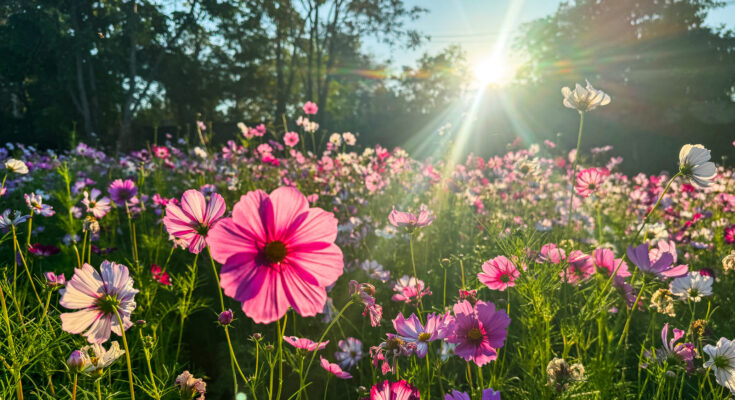15 Low-Maintenance Flowering Plants That Will Thrive In The Sun
We may receive a commission on purchases made from links.
Sure, the sun powers all life on Earth, but it can also be a bit much sometimes, particularly for gardeners. Along with creating intense temperatures that makes gardening a lot more sweaty and arduous, high amounts of sunlight can be detrimental to certain plants. Luckily, it’s easy to take advantage of an especially sunny yard by opting for flowers that require a lot of hours of direct sunlight. Additionally, by picking flowers that thrive in the sun and are also low-maintenance, you can curate a summertime garden that you can enjoy without having to constantly toil under the harsh rays yourself.
Many flowers that are drought tolerant and require a lot of sun are also native to regions with those climates. Planting wildflowers and other native cultivars makes the process of gardening easier since you don’t have to alter the environment to meet the plant’s ideal conditions. This often results in lower water usage, less overall damage, and reduced erosion to your property. Not to mention, native flowers attract pollinators and wildlife that help the entire ecosystem. From yarrow to allium to cosmos and more, these trouble-free, solar-powered flowers can make maintaining your garden easier on you and the environment.
Stonecrop
Sedum is a group of plants that include species like white stonecrop (Sedum album) and two-row stonecrop (Sedum spurium). Also known as stonecrop, these pillowy, densely flowered plants are actually succulents, which means they are extremely adaptable to hot, dry conditions throughout hardiness zones 3 to 9. Stonecrop comes in a variety of colors, and usually makes for wonderful ground cover. They also aren’t fussy about soil type, and can even thrive in rocky soil. Once your sedum plants are properly introduced to the garden, they’ll likely become one of your least demanding flowers.
Iris
The iris family of flowers has over 300 members, most of which are generally low maintenance in zones 3 to 9. Irises are a great choice for outdoor spaces that receive a lot of sun, since most species do best with at least six hours of direct sunlight a day. They also can easily become soggy, and especially drought-resistant species like spuria iris (Iris spuria) can go weeks without needing to be watered. The majority of irises grow best in loose soil, making them a good choice for rock gardens.
Dianthus
Dianthus flowers like China pinks (Dianthus chinensis) and cottage pinks (Dianthus plumarius) are a genus of plants with vibrant pink blooms. Pinks, as they’re sometimes called, are generally hardy from zones 4 to 9, though there are some species that can thrive in zones 3 and 10 as well. With full sun and watering only required when the soil is dry, dianthus will bloom all summer long. Like other heat-tolerant flowers, pinks need loose soil that won’t collect water. If needed, you can use different drainage materials to relieve plants of excess moisture.
Black-eyed Susans
For an iconic sun-loving bloom that will be hardy in zones 4 to 9, look no further than black-eyed Susans (Rudbeckia hirta). With their sharp yellow petals and dark brown middle, these blooms look a bit like mini sunflowers, and will make just as much of a statement in your garden. Rudbeckias love the sun, and once they’ve been established, you can expect them to thrive with little to no effort on your end. But don’t forget about them completely — if left unattended, black-eyed Susans can quickly grow to overfill a garden plot.
Allium
With its puffy blossom and towering stalk, allium makes a unique addition to any sun-soaked yard. These whimsical flowers are actually part of the same genus as garlic and chives, and are appropriately referred to as ornamental onions. Some species, like Allium hollandicum ‘Purple Sensation,’ can grow to be 3 feet tall; perfect for a natural border or garden focal point. Allium flowers are hardy and drought tolerant through zones 4 to 10, and as long as they have well-draining soil and lots of sun, allium flowers can provide stunning beauty to your outdoor space for years.
Zinnias
Another flower variety that likes lots of sun and dry soil are zinnias (Zinnia elegans). Available in a range of colors and petal patterns, zinnia species grow tall and fast. Exceptionally adaptable, zinnias will thrive in zones 2 to 11, where their blooming season can last into winter. That means that as long as they get at least six hours of sunlight a day, zinnias can do well in both hot and cold climates. While zinnias need a bit more watering than other entries on this list, they still can become easily overwatered and are otherwise simple to maintain.
Cosmos
Cosmos (Cosmos bipinnatus) are also hardy in zones 2 to 11, and grow well alongside zinnias. The multi-colored flowers are super tolerant of high heat, dry conditions, and even high humidity — in fact, they often prefer it. Just give them a splash of water during long periods of drought, and they should grow without issue. One issue with cosmos is that they may grow so tall, they might fall over. If this happens, try organizing your garden so that the cosmos can be held up by other plants, or pick up some plant support stakes.
Yarrow
Yarrow (Achillea millefolium), is a long-stemmed plant distinguished by the flying-saucer-shaped cluster of flowers that adorns each stalk. Best grown in zones 3 to 9, yarrow thrives in dry soil and constant, direct sun. Yarrow is so drought tolerant, it would actually be less harmful to give it too little water than too much. Of course, both over- and under-watering are mistakes you should avoid when watering your garden. Similar to some other wildflowers, the hardy and adaptable nature of yarrow means that it can become invasive if left unchecked in ideal conditions.
Hibiscus
While many flowers that thrive with lots of sun also prefer drier conditions, some blooms like a combination of sunlight and humidity. For those who live somewhere with a hardiness zone of 4 to 11 that has high humidity, various members of the Hibiscus flower group can be extremely easy to care for. In general, hibiscus does very well with direct sun, but may benefit from periods of shade if located in an especially hot area. A species like swamp hibiscus (Hibiscus coccineus) would thrive effortlessly when planted in the moist soil near a water feature like a pond.
Lavender
The relaxing, effervescent aroma of lavender (Lavandula) is enough of a reason to sow it in your garden, but it doesn’t hurt that these purple flowers also have a hassle-free growing process. After its first year, lavender never needs to be watered, and in fact should be kept in well-drained soil to protect it from any excess moisture. To that end, lavender should also be planted somewhere with full sun in hardiness zones 5 through 9, and protected from cold conditions.
Angelonia
If you need a fuss free flower that can handle both heat and humidity, go for angelonia (Angelonia angustifolia). These pink, purple, and white flowers need a lot of sun — at least six hours a day, though more is preferable — in order to reach their full potential. Angelonia does well in the high heat of zones 9 to 11, and can survive in dry or humid conditions. Once the plant has matured, it can tolerate drought, though it does best with slightly moist soil.
Blanket flower
The blanket flower (Gaillardia) is a common sight across the North American plains, where it covers entire fields with red, orange, and yellow blooms. Once they’ve been established, blanket flowers hardly ever need to be watered, and thrive in arid, sunny spots. Blanket flowers can thrive practically everywhere in the United States (zones 3 to 10), and as long as they stay dry, these charming flowers will fill your outdoor space with color all summer long.
Coneflower
Whether you call them coneflowers or echinacea, there’s no debate that these vibrant wildflowers will make your gardens stand out. With their button-like centers and numerous rich colors ranging from purple to orange, coneflowers are as durable as they are charming. Hardy in zones 3 to 9, these flowers are generally drought-tolerant once established, and can grow in both dry and rich soil.
Salvia
The salvia plant genus has similar requirements to coneflower: full sun, average soil, and enough water every now and then to keep it from drying up. As a rule of thumb, salvia should be watered frequently enough to keep the top couple inches of soil moist. Still, in zones 5 to 10, salvia does great in the heat, and some species like Autumn sage (Salvia greggii) are more heat tolerant than others. Once your salvia plant is growing strong, learn how to prune salvia flowers for endless blooms all summer.
Pentas
Pentas (Pentas lanceolata), a.k.a. star cluster, is a tropical plant best suited for hot, humid regions throughout hardiness zones 10 and 11. The star-shaped blooms need to receive full sun to fully flower, and can typically go without manual watering once they’ve matured. Even if you live in a lower hardiness zone, you can still grow pentas annually by ensuring your plant gets plenty of sunlight and stays as warm as possible. If you do end up having to water it during a dry spell, avoid getting the leaves or petals wet, as this might encourage fungal development.



